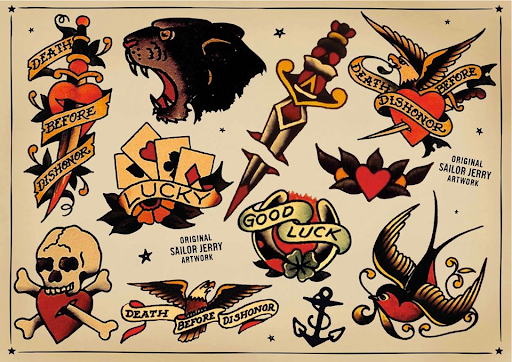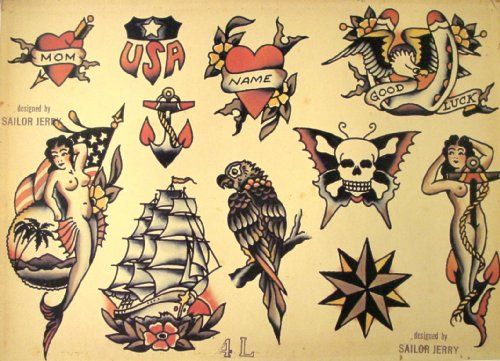Sailor Jerry: The Legend Who Defined American Traditional Tattooing
- Inked Abroad

- Aug 11, 2024
- 5 min read
Updated: Aug 25, 2024

The world of tattooing owes much of its modern identity to a man named Norman "Sailor Jerry" Collins, a trailblazer whose innovations and artistic vision forever changed the craft. Born in 1911, Sailor Jerry wasn't just a tattoo artist; he was a cultural icon who infused his art with a boldness and style that became synonymous with American traditional tattooing. His life was a tapestry of adventure, rebellion, and artistry, each chapter more fascinating than the last.
Early Years: From the Open Road to the High Seas
Norman Collins was born in Reno, Nevada, but his spirit was shaped by a lifetime of travel and adventure. As a young teenager, he hopped freight trains across the country, learning the trade of tattooing on the streets and in the back alleys of America. His first tattoos were done with rudimentary tools—a needle and thread dipped in ink—and an unyielding desire to carve out his place in the world. This period of self-taught exploration helped him develop a rugged style that would come to define his career.
At 19, Collins joined the U.S. Navy, a decision that would deeply influence his tattooing career. The Navy introduced him to the traditions of maritime tattooing, a rich heritage that sailors carried with them from port to port. It was during his naval service that Collins adopted the nickname "Sailor Jerry," a moniker that would become legendary. The Navy not only exposed him to the classic motifs of anchors, swallows, and daggers but also broadened his horizons as he encountered various styles of tattooing around the world, particularly in Southeast Asia.
Honolulu: The Heart of Sailor Jerry's Tattoo Revolution
After leaving the Navy, Sailor Jerry settled in Honolulu, Hawaii, in the 1930s, where he opened his own tattoo shop in the city's notorious Chinatown. At that time, Honolulu was a bustling port city filled with sailors from all over the world. It was here that Sailor Jerry truly honed his craft, establishing himself as a master of the American traditional style—a bold, colorful, and iconographic approach that drew heavily from the naval and maritime themes he encountered in the Navy.
Honolulu's multicultural environment provided a fertile ground for Collins to experiment and innovate. He was influenced by Japanese tattoo masters, whose work he admired for its bold use of color and detailed artistry. Sailor Jerry integrated these elements into his own work, elevating the standards of American tattooing by adopting Japanese techniques such as large-scale designs and incorporating vibrant colors and intricate shading.
Innovation and Mastery: Elevating the Craft of Tattooing
Sailor Jerry wasn't just a tattoo artist; he was an innovator and a craftsman deeply committed to the quality and integrity of his work. He revolutionized tattooing by introducing sterilization practices long before they became industry standards, insisting on using hospital-grade sterilization equipment in his shop. This emphasis on cleanliness and safety was revolutionary at a time when tattooing was still seen by many as a risky, underground practice.
Collins also invented new machines and pigments that allowed for brighter, longer-lasting colors. His dedication to using only the highest quality materials ensured that his tattoos would endure as timeless pieces of art. Sailor Jerry’s innovations didn’t stop there; he also developed his own techniques for shading and outlining, creating a distinct style characterized by its bold, clean lines and vibrant colors that are still revered and emulated by tattoo artists today.
A prolific artist, Sailor Jerry is known for his iconic flash designs, which include classic symbols such as pin-up girls, eagles, anchors, swallows, and snakes. These images, with their clear lines and vivid colors, have become the defining characteristics of American traditional tattooing. Each design was more than just an image; it was a story, a statement of identity, and a piece of wearable art that carried the spirit of Sailor Jerry himself.
A Tattoo Artist, Philosopher, and Rebel
Beyond his technical skill and innovation, Sailor Jerry was known for his outspoken personality and philosophy on life and art. He believed that tattooing was a sacred craft, a form of self-expression that deserved respect and dedication. His no-nonsense attitude often clashed with those he saw as less committed to the craft. He was notorious for turning away customers whom he felt were not getting tattoos for the right reasons, emphasizing the importance of understanding and appreciating the art.
Sailor Jerry also had a rebellious streak. He was a staunch patriot and a man of strong convictions, often using his tattoos to make political statements or reflect his beliefs. During World War II, many of his designs featured anti-Japanese sentiment, reflecting the broader cultural attitudes of the time. Despite his often controversial views, Sailor Jerry’s work transcended his personal beliefs, appealing to a broad audience drawn to his skill and the power of his artistry.
Legacy: The Father of American Traditional Tattooing
Norman "Sailor Jerry" Collins passed away in 1973, but his influence on the world of tattooing remains profound. He is often credited as the father of American traditional tattooing, a style that continues to thrive today. His flash art designs are still some of the most popular and recognizable images in tattoo culture, and his techniques and philosophies have been passed down through generations of tattoo artists.
After his death, Sailor Jerry’s legacy continued through the efforts of his protégés, Ed Hardy and Mike Malone, who took over his shop in Honolulu and helped to perpetuate his style and approach. They maintained the high standards and bold designs that had become synonymous with Sailor Jerry, ensuring that his influence would live on.
In addition to his direct impact on tattooing, Sailor Jerry’s name has become a brand, extending his legacy beyond the tattoo community. The Sailor Jerry Rum brand, created in his honor, celebrates his spirit of rebellion and craftsmanship, bringing his name and influence to a global audience.
Conclusion: A Lasting Impact on Tattoo Culture and Beyond
Sailor Jerry's life and work represent a critical turning point in the history of tattooing. His dedication to innovation, his commitment to the craft, and his unique style have left an indelible mark on the world of tattoo art. By elevating the standards of tattooing, advocating for its artistry, and embracing the rebellious spirit of his time, Sailor Jerry helped to shape tattoo culture into what it is today—a respected form of art and personal expression.
Whether through his iconic flash designs, his advancements in tattoo technology and hygiene, or the enduring brand that bears his name, Sailor Jerry’s influence remains a cornerstone of tattoo history. His story is one of passion, innovation, and a relentless pursuit of excellence, inspiring countless artists and enthusiasts to continue exploring the art of tattooing with the same fearless spirit.
Citations:
Sailor Jerry Official Website: "The Story of Norman 'Sailor Jerry' Collins"
Aloha Monkey Tattoo: "Sailor Jerry Tattoo: The History and Innovation"
The Manual: "The Real Sailor Jerry: The Story Behind the Tattoo Legend"
Image source: "[Description or Title of Image]," Tattoo Box Montreal, accessed August 11, 2024, https://www.tattooboxmontreal.com/wp-content/uploads/2023/04/CFF214AD-8AD3-49F0-8878-5832A8486117.webp.







![Image source: "[Description or Title of Image]," Medium, accessed August 11, 2024, https://miro.medium.com/v2/resize:fit:976/1*B-Ax3NE-E3U-YokNOevd6g.jpeg.](https://static.wixstatic.com/media/04f48b_4496122e11cc49c0b9b17aa69eadd5d4~mv2.jpg/v1/fill/w_205,h_206,q_90,enc_avif,quality_auto/04f48b_4496122e11cc49c0b9b17aa69eadd5d4~mv2.jpg)



















Comments